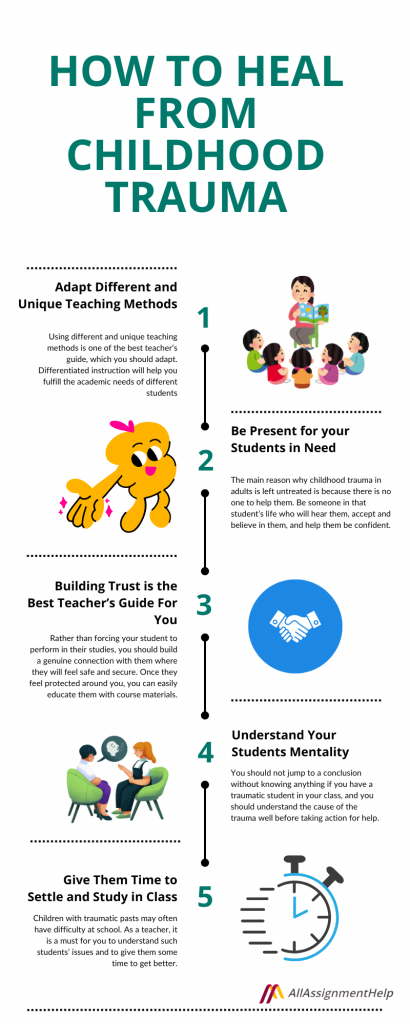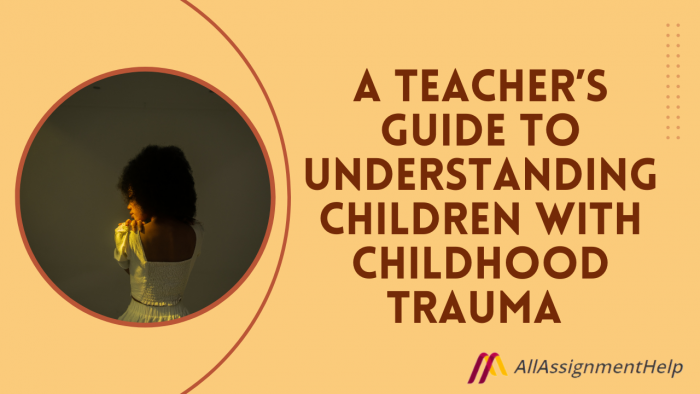Table of Contents
Teachers are said to be the second parents of children. They are the ones who can shape a young life, and a teacher’s guide is helpful to children in various ways. The educator is responsible for providing the best academic knowledge to students, which helps them succeed in their careers. However, there are a few instructors who just focus on academic growth and neglect the other needs of students. As a teacher, your main responsibility is to foster both growth and learning. If you are seeing any students with signs of childhood trauma, you should provide them with the necessary care that will help in their emotional, psychological, and physical development.
However, to create a healing and growth environment, you should first understand everything about childhood trauma. Through this write-up from AllAssignmentHelp.com, we have tried to give you an idea of how you can understand kids with childhood trauma. This teacher’s guide will help students fight their fears and overcome their trauma.
Read also: Good And Bad Impacts Of Technology On Children And Their Education
What Is Childhood Trauma?
Childhood trauma is a kind of distress that occurs in a child’s life between birth and the age of six. The first three years are a crucial stage where students grow and adapt to everything. Any problem that results in this phase is called trauma, which can stay in their life for a lifetime. There is a common misconception that only the lives of children who live in poverty experience this kind of trauma. However, there is no such thing as proof that any child can experience traumatic events. Childhood trauma has an impact on how people feel, think, and act. It has an impact on one’s view of oneself as well as one’s ideas about other people and the world.
Signs of childhood trauma can include the following; however, this list is not exhaustive:
- Medical crises
- Accidents or injuries (like a house fire or car collision that threatens the student’s safety)
- Bullying or harassment
- Family separation (due to incarceration, deployment, divorce, foster placement, or death)
- Developing eating disorders
- Self-harming behaviors
- Natural disaster
- Abuse (emotional, physical, or sexual)
- Neglect
- Observation of domestic, community, or school violence
- Substance abuse
- Mental illness
- Terrorism and war
- Instability due to being unhoused
- Poverty
- Overt discrimination or constant microaggressions
- Refugee or undocumented status
Trauma might be difficult to diagnose and recognize, and it is also unique to each person. A traumatic incident for one individual may not be traumatic for another. Furthermore, different people may have various trauma symptoms as a result of the same event.
Read also: Ways to Help Children in Writing Creatively
A Teacher’s Guide on How to Heal from Childhood Trauma
Trauma has been or is being experienced by children, adolescents, and teens. According to the National Survey of Children’s Health, nearly 45% of students in the USA have experienced childhood trauma in their lives and 8% reported a lifetime prevalence of sexual assault. Moreover, 39% reported witnessing violence and 17% reported physical assault. With this fact, it is clear that traumatic events have been easing, and this needs serious guidance. Whether it is preschool children, elementary school children, middle school children, or high school children, everyone goes through some kind of serious incident that leaves a scar in their life. For some children, these things become unmanageable, which starts affecting their academic lives. To overcome this, they prefer to seek help from assignment writing services.
Trauma’s effects may be far-reaching and long-lasting, affecting pupils’ capacity to access education. However, an experienced teacher can handle a traumatic child very gently. Some of the ways to assist traumatized students in the classroom are:
- Pursue professional development in the area of working with specific identity groups.
- Self-assessment and reflection on your trauma responsiveness should be done on a regular basis.
- You can also prepare a childhood trauma questionnaire which will help you understand traumatized students better.
- Introduce different childhood trauma test to student’s parents, which will help them understand the importance of how traumatic events affect children.
Let’s have a look at what is in the teacher’s guide and how children with early childhood trauma can be treated:

Give Them Time to Settle and Study in Class
Children with traumatic pasts may often have difficulty at school. They may need help to concentrate well on the lecture, may submit their academic homework a bit late, or may not be able to reach school on time. It could take a toll on your mind, and you may get angry at such kids without knowing their problems. Thus, as a teacher, it is a must for you to understand such students’ issues and to give them some time to get better.
If you are a student experiencing any kind of trauma, it is possible to miss your online class submissions. However, you can hire someone with requests like, Can you do my online class for me from Google? Before anything else, your trauma should be treated, as it can leave scars for your whole life.
Make Them Feel Confident
It is quite understandable that it’s not easy for kids with traumatic pasts to live their lives even after the trauma. Not only do memories keep haunting them, but they also keep worrying about what will happen next. This way, it gets tough for such students, and their academics are greatly affected. You can be the person who can help them feel confident by counseling them and sharing a smile with them.
Adapt Different and Unique Teaching Methods
In the classroom, a daily routine may be soothing, so strive to give certainty wherever feasible. Because words may not register with traumatized youngsters, different sensory clues are required. Have signs or a storyboard that outlines which activity—math, reading, lunch, recess, etc.—the class will do and when in addition to outlining how the day will flow. Knowing what to expect allows children to concentrate on their studies. With time, this might demonstrate to children that they can persevere and succeed in school.
Using different and unique teaching methods is one of the best teacher’s guide, which you should adapt. Differentiated instruction will help you fulfill the academic needs of different students.
Understand Your Students Mentality
People relate traumas to violence most of the time. It is true that it’s one of the most common causes of trauma for kids. However, many other things could be the cause of the young students suffering from trauma; parents’ divorce, being bullied, or too much homework are some of those.
So, you should not jump to a conclusion without knowing anything if you have a traumatic student in your class, and you should understand the cause of the trauma well before taking action for help.
Also Read: Child psychology – A vital branch of Psychology
A Supportive Friend Can Do Wonders
As mentioned above, young students with traumatic childhoods keep worrying over what will happen in the future or whether they will ever be able to come out of the stress they have. It makes them negative about life, and they can’t understand their worth.
Thus, such kids require support from you and the parents to realize that they can do everything and that they will only hurt themselves by getting worried over something. Students often experience stress due to academic assignment overload. Such students can seek online assignment help from professional writers and timely submit all their assignments without compromising their grades or health.
Be Present for your Students in Need
The main reason why childhood trauma in adults is left untreated is because there is no one to help them. Be someone in that student’s life who will hear them, accept and believe in them, and help them be confident. Try to be present in their lives and guide them towards the right path. If possible, you can provide them with counselling during school hours; if not, make sure to talk to them after school hours.
Foster a Supportive Classroom Community
Create a welcoming, safe environment in your classroom by reassuring students that you understand and support their predicament. Kids who have been through trauma have a hard time learning unless they feel protected and supported. “The more the instructor can do to make the kid feel less worried and to help the youngster focus on the work at hand, the better the child’s performance will be. There is a definite link between stress reduction and improved academic performance.”
Give Them Intervals Between Classroom Sessions
Some traumatized children have emotionally inaccessible parents. The incapacity to self-soothe is the outcome. They could acquire distracted tendencies and find it difficult to stay concentrated for lengthy periods of time. Schedule regular brain breaks and encourage social-emotional development to help kids manage. Tell the class when there will be free time, games, or stretching breaks at the start of the day.
Building Trust is the Best Teacher’s Guide For You
Students who have faced trauma in their childhood often face problems building trust and relationships. They even experienced this issue in their childhood, which affected their academic experience. Rather than forcing your student to perform in their studies, you should build a genuine connection with them where they will feel safe and secure. Once they feel protected around you, you can easily educate them with course materials.
Take Care of Yourself First
Working with a traumatic child might not be easy. It might affect your life as well, and managing your other work might not be easy. If you want to support a childhood trauma, you should first take good care of yourself. If you want any support or help, you can refer to other teachers’s guide on childhood trauma or seek supervision.
The teacher plays an important role in helping a child overcome their childhood trauma. If you are looking for a teacher’s guide to understanding early childhood trauma in students, then you should make sure to refer to the above-given points. Once you learn everything in detail, you can foster trauma-informed classrooms.
Read: How can parents assist their children with their homework?
Frequently Asked Questions
| Question 1: What are the types of childhood trauma? Physical abuse, emotional abuse, sexual abuse, chronic illness or disability, and emotional and physical neglect are a few examples of childhood trauma. |
| Question 2: Is it possible to recover from childhood trauma? Yes, it is possible to recover from unresolved childhood trauma. Seek help from a therapist who is trained in psychoanalysis or psychodynamics. A therapist who is familiar with the impact of traumatic childhood experiences on adult life. |
